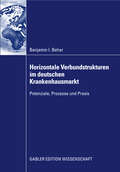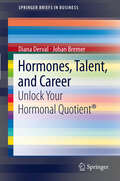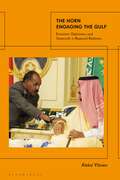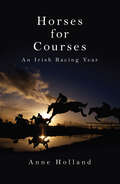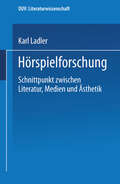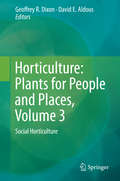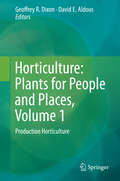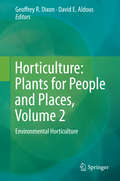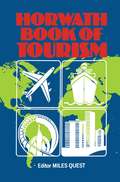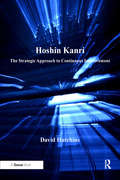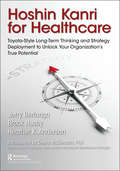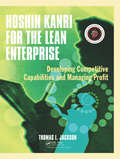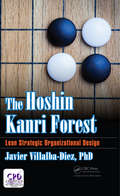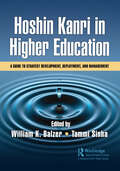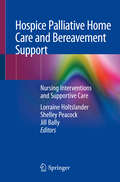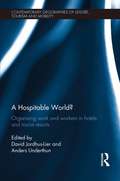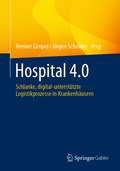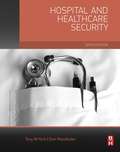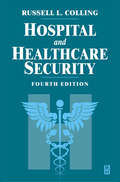- Table View
- List View
Horizontale Verbundstrukturen im deutschen Krankenhausmarkt: Potenziale, Prozesse und Praxis
by Benjamin Isaak BeharBenjamin I. Behar untersucht, inwieweit Krankenhäuser in verschiedenartig organisierten Verbundtypen den Anforderungen gerecht werden können, ihre operative Exzellenz zu steigern und sich an die sich ständig ändernden institutionellen Rahmenbedingungen anzupassen.
Hormones, Talent, and Career: Unlock Your Hormonal Quotient® (SpringerBriefs in Business)
by Diana Derval Johan BremerThe media now regularly feature breakthroughs on the influence of prenatal hormones on the brain and behavior, for instance the link to financial performance or risk management. Based on these findings and their own experiments, the authors present the Hormonal Quotient (HQ) as a scientific, holistic and reliable career management and personal development tool for professionals. Eight HQ profiles and their corresponding typical business skills and preferences are presented and enable the reader to benchmark their HQ with peers, design an ideal career plan, build a winning team in business and find the perfect work-life balance. A complimentary website allows readers to easily measure their HQ online.By the author of "The Right Sensory Mix", Berry-AMA Book Prize Finalist 2011.
The Horn Engaging the Gulf: Economic Diplomacy and Statecraft in Regional Relations
by Dr Aleksi YlönenThis book discusses theoretical perspectives of analyzing the relations between the states and non-state actors in the Horn of Africa and their counterparts in the Persian Gulf and the Middle East. Crucially, these relations are examined primarily from the perspective of the diplomatic, economic, and strategic agency of the African states and societal actors. Here, domestic political dynamics and local power play a significant role. Aleksi Ylönen provides a historically informed investigation of recent relations that involve the Gulf States and Türkiye's resurgent interest in the Horn Africa. The analysis focuses on the post-Arab Spring period following the Iran nuclear deal and the war in Yemen. Featuring case studies from Ethiopia, Somalia, and Eritrea which highlight engagements of the Horn state and societal actors primarily with the Gulf States and Türkiye, the study provides an empirical analysis of the interactions and connections between the two regions.
The Horn Engaging the Gulf: Economic Diplomacy and Statecraft in Regional Relations
by Dr Aleksi YlönenThis book discusses theoretical perspectives of analyzing the relations between the states and non-state actors in the Horn of Africa and their counterparts in the Persian Gulf and the Middle East. Crucially, these relations are examined primarily from the perspective of the diplomatic, economic, and strategic agency of the African states and societal actors. Here, domestic political dynamics and local power play a significant role. Aleksi Ylönen provides a historically informed investigation of recent relations that involve the Gulf States and Türkiye's resurgent interest in the Horn Africa. The analysis focuses on the post-Arab Spring period following the Iran nuclear deal and the war in Yemen. Featuring case studies from Ethiopia, Somalia, and Eritrea which highlight engagements of the Horn state and societal actors primarily with the Gulf States and Türkiye, the study provides an empirical analysis of the interactions and connections between the two regions.
Horses for Courses: An Irish Racing Year
by Anne HollandThere can be no better way of getting to know Ireland than by visiting its racecourses: from the glamour of Leopardstown and the class of The Curragh to the majestic mountains around Killarney; from the warm welcome at Gowran Park and Clonmel to the summer holidaymakers' meetings and 'industry' days in the winter months. At any one of these venues, you might catch a glimpse of a future Cheltenham Gold Cup champion or Derby winner in action.Horses for Courses guides readers through a typical year in Irish racing and highlights the individuality of each venue. All have their own special qualities and atmosphere but share two common traits: a warm welcome and good sport. And that is what the author believes Irish racing is all about.The country's courses enjoy a huge level of support from the local population. It might be raining and some of the races may be 'ordinary' but the stands will always be crowded. That is because racing is part of Irish culture and the nation's way of life: with 27 courses, it has proportionately far more venues than Great Britain.Meticulously researched and passionately written, Horses for Courses is the definitive guide to Ireland's racecourses and is essential reading for horse-racing enthusiasts everywhere.
Hörspielforschung: Schnittpunkt zwischen Literatur, Medien und Ästhetik (Literatur - Handlung - System)
by Karl LadlerKarl Ladler untersucht, was ein Hörspiel ist: ein literarisches Produkt, ein von vielen Personen hergestelltes Medienereignis und/ oder ein ästhetisches Werk.
Horticulture: Social Horticulture
by Geoffrey R. Dixon David E. AldousThis Trilogy explains “What is Horticulture?”. Volume three of Horticulture: Plants for People and Places presents readers with detailed accounts of the scientific and scholastic concepts which interact with the arts and humanities and which now underpins the rapidly evolving subject of Social Horticulture. This discipline transcends the barriers between science, medicine and the arts. This volume covers:- Horticulture and Society, Diet and Health, Psychological Health, Wildlife, Horticulture and Public Welfare, Education, Extension, Economics, Exports and Biosecurity, Scholarship and Art, Scholarship and Literature, Scholarship and History and the relationship between Horticulture and Gardening. This volume brings the evolution of the Discipline and Vocation of Horticulture firmly into the 21st Century. It covers new ground by providing a detailed analysis of the value of Horticulture as a force for enhancing society in the forms of social welfare, health and well-being, how knowledge is transferred within and between generations, and the place of Horticulture in the Arts and Humanities. Substantial emphasis is given to the relationships between health, well-being and plants by the internationally acclaimed authors who have contributed accounts of their work in this book.
Horticulture: Production Horticulture
by Geoffrey R. Dixon David E. AldousThis Trilogy explains “What is Horticulture?”. Volume one of Horticulture: Plants for People and Places describes in considerable depth the science, management and technology which underpins the continuous production of fresh and processed horticultural produce. Firstly, there is a consideration of technological innovation derived from basic scientific discoveries which has given rise to entirely new industries, markets, novel crops and changed social habits. Then follows accounts of the modern production of: Field Vegetables, Temperate Fruit, Tropical Fruit, Citrus, Plantation Crops, Berry Crops, Viticulture, Protected Crops, Flower Crops, New Crops, Post-harvest Handling, Supply Chain Management and the Environmental Impact of Production. Each chapter is written by acknowledged world experts. Never before has such an array of plentiful, high quality fresh fruit, vegetables and ornamentals been available year-round in the World’s retail markets. Horticulture gives consumers this gift of nutritious, high quality, safe and diverse fresh foods. This is achieved by manipulating plant growth, reproduction and postharvest husbandry. The multi-billion dollar international industry achieving this is Production Horticulture the subject of this informative book.
Horticulture: Environmental Horticulture
by Geoffrey R. Dixon David E. AldousThis Trilogy explains “What is Horticulture?”. Volume two of Horticulture: Plants for People and Places analyses in depth the scientific, managerial and ecological concepts which underpin Environmental Horticulture. Chapters describe: Horticulture and the Environment, Woody Ornamentals, Herbs and Pharmaceuticals, Urban Greening, Rural Trees, Urban Trees, Turfgrass Science, Interior and External Landscaping, Biodiversity, Climate Change and Organic Production. Each is written by leading international experts. Sustainable use of resources and careful conservation are critically essential for the continuation of life on this Planet. Achieving this is where horticulture, natural flora and fauna and the environment interact in achieving sustainable development. Horticulture is the fundamental partner of ecological and environmental science and provides an understanding of eco-system services. Live plant networks are essential for rural and urban life. They are integral parts of natural communities, the context of historic and modern architecture and a means for rejuvenating cities and uniting communities. Plants provide urban, peri-urban and rural employment, business and tourism opportunities, leisure, rest and relaxation. These facets of Environmental Horticulture are clearly described in this book.
Horwath Book of Tourism
by Miles QuestThe Horwath Book of Tourism looks at the factors involved in the past and future development of tourism through the eyes of nearly 30 independent authors from Europe and America, all of them specialists in their field. The book examines the component parts of the tourism industry and seeks to present a broad picture of international tourism - one of the most dynamic industries in the world - presenting at the same time, some solutions to the problems which it faces in the next decade.
Hoshin Kanri: The Strategic Approach to Continuous Improvement
by David HutchinsThe results of the quality revolution have been mixed. Global competition has elevated the most successful companies, in terms of providing goods and services, but even then initiatives such as total quality, business process re-engineering and Six Sigma have been heralded as the solution, only to have been replaced with the next 'big thing' when it came along. Hoshin Kanri is not the next big thing in quality, it is a strategic approach to continuous improvement that provides a context for all of the individual elements such as Six Sigma or Lean Manufacturing. David Hutchins' Hoshin Kanri shows you how to develop a dynamic vision for continuous improvement; to implement effective policies to support it; to link key performance indicators to Six Sigma, Lean Manufacturing and Kaizen and to sustain a strategy-led programme for improving business performance.
Hoshin Kanri: The Strategic Approach to Continuous Improvement
by David HutchinsThe results of the quality revolution have been mixed. Global competition has elevated the most successful companies, in terms of providing goods and services, but even then initiatives such as total quality, business process re-engineering and Six Sigma have been heralded as the solution, only to have been replaced with the next 'big thing' when it came along. Hoshin Kanri is not the next big thing in quality, it is a strategic approach to continuous improvement that provides a context for all of the individual elements such as Six Sigma or Lean Manufacturing. David Hutchins' Hoshin Kanri shows you how to develop a dynamic vision for continuous improvement; to implement effective policies to support it; to link key performance indicators to Six Sigma, Lean Manufacturing and Kaizen and to sustain a strategy-led programme for improving business performance.
Hoshin Kanri for Healthcare: Toyota-Style Long-Term Thinking and Strategy Deployment to Unlock Your Organization’s True Potential
by Gerard A. Berlanga Brock C. Husby Heather K. AndersonThe best healthcare organizations have developed effective approaches to develop compelling strategic visions and strategies based on long-term thinking and continue to apply Lean principles across their organizations to create a culture of continuous improvement. Establishing effective strategies and Toyota style Hoshin Kanri enables healthcare organizations to align everyone in the organizations and creates a unique competitive advantage. This book follows a regional hospital's journey through the creation of long-term strategic goals and Toyota Style strategy deployment.
Hoshin Kanri for Healthcare: Toyota-Style Long-Term Thinking and Strategy Deployment to Unlock Your Organization’s True Potential
by Gerard A. Berlanga Brock C. Husby Heather K. AndersonThe best healthcare organizations have developed effective approaches to develop compelling strategic visions and strategies based on long-term thinking and continue to apply Lean principles across their organizations to create a culture of continuous improvement. Establishing effective strategies and Toyota style Hoshin Kanri enables healthcare organizations to align everyone in the organizations and creates a unique competitive advantage. This book follows a regional hospital's journey through the creation of long-term strategic goals and Toyota Style strategy deployment.
Hoshin Kanri for the Lean Enterprise: Developing Competitive Capabilities and Managing Profit
by Thomas L. JacksonWinner of a Shingo Research and Professional Publication Award!At the heart of Lean and Six Sigma is the same, unique business operating system: hoshin kanri. It is a method of strategic planning and a tool for managing complex projects, a quality operating system geared to ensuring that organizations faithfully translate the voice of the customer into new products, and a business operating system that ensures reliable profit growth.The true power of hoshin kanri, however, is two-fold -- it is a superior organizational learning method as well as a competitive resource development system. Hoshin Kanri for the Lean Enterprise, by Tom Jackson, explains how you can implement, identify and manage the critical relationships among your markets, design characteristics, production systems, and personnel to satisfy your customers and beat your competition. This practical workbook provides— A new understanding of hoshin kanri as a grand experimental design implemented through a system of team agreements. Clear explanations of the steps of hoshin kanri. A measure of overall business effectiveness used to determine the focus of corporate strategy. A new, improved X-matrix that incorporates a lean "balanced scorecard" for identifying improvement opportunities and converting them readily into bottom line results as a value stream P&L in terms that financial managers and accountants can understand and support. A CD containing forms, meeting agendas, and examples of X-matrices that serve marketing and design engineering as well as manufacturing. This workbook will show you the mechanics of implementing hoshin kanri, so that you can systematically improve your brand equity, implement Lean manufacturing and Six Sigma, and integrate your suppliers into a Lean and Six Sigma organization.
The Hoshin Kanri Forest: Lean Strategic Organizational Design
by Javier Villalba-Diez, PhDStrategic Lean management efforts significantly fail because leaders often lack a map of their organizations. Written in a colloquial manner, The Hoshin Kanri Forest is for Lean practitioners who seek to design organizational structures that functionally support the dynamics associated with Lean Management. This book will provide a comprehensive quantifiable framework for strategically designing organizations for Lean management. Combining knowledge about strategic organizational design and Lean management, the author introduces a theory called the Hoshin Kanri Forest that considers organizations as networks with organizational structure, functional connectivity, and effective dynamic patterns for attaining an optimal strategic organizational design towards the strategic goal of Lean management. It presents the future of Lean organizations relying on strategically designing its structure, function, and effective dynamics. This book is about describing an evolutional approach toward a peaceful Lean revolution. It includes useful insights into organizational key-performance-indicator dynamics, gives leaders an implementation roadmap, and offers real examples from the author’s professional experience.
The Hoshin Kanri Forest: Lean Strategic Organizational Design
by Javier Villalba-Diez, PhDStrategic Lean management efforts significantly fail because leaders often lack a map of their organizations. Written in a colloquial manner, The Hoshin Kanri Forest is for Lean practitioners who seek to design organizational structures that functionally support the dynamics associated with Lean Management. This book will provide a comprehensive quantifiable framework for strategically designing organizations for Lean management. Combining knowledge about strategic organizational design and Lean management, the author introduces a theory called the Hoshin Kanri Forest that considers organizations as networks with organizational structure, functional connectivity, and effective dynamic patterns for attaining an optimal strategic organizational design towards the strategic goal of Lean management. It presents the future of Lean organizations relying on strategically designing its structure, function, and effective dynamics. This book is about describing an evolutional approach toward a peaceful Lean revolution. It includes useful insights into organizational key-performance-indicator dynamics, gives leaders an implementation roadmap, and offers real examples from the author’s professional experience.
Hoshin Kanri in Higher Education: A Guide to Strategy Development, Deployment, and Management
by William K. Balzer Tammi SinhaStrategy, the link between mission and operational plans to improve an institution’s performance, is a critical element to the future success of higher education (HE). Hoshin Kanri (HK), the application of Lean principles and practices to strategy development, deployment, and management, is a systematic and effective approach to support institutional success, particularly when competition is high. Surprisingly, despite its known effectiveness and advantages over other approaches to strategy development, deployment, and management, the application of HK in HE is limited. This book promotes greater awareness, appreciation, and application of HK at HE institutions. The book is divided into four sections: The first section (Introduction to Hoshin Kanri) provides a general overview of HK and its potential contributions when used in HE settings. The second section (Case Studies) provides several examples where aspects of HK were introduced at HE institutions. These case studies, which vary in scope, use of HK practices and tools, and identified benefits, offer insights both for helping senior leaders recognize the value of HK (and adopt the HK process) and for on-the-ground experiences using HK tools and techniques – including barriers and challenges – during implementation. The third section (Expanding the Application of Hoshin Kanri in Higher Education) includes several chapters on how to begin an HE institution’s HK journey. The chapters include practical steps for gaining support for and implementing HK strategy development, deployment, and management tailored for HE institutions across both typical and novel applications of HK. The fourth and final section (Implications for Practice and Research) presents a high-level summary of the "current state" of HK in HE and offers thoughts and recommendations on the "future state" directions for practice, research opportunities, and challenges for HK in HE. The book underscores the key benefits HK can offer HE institutions. With its Lean roots of continuous improvement and respect for people, HK offers HE institutions an effective and sustainable approach to strategy development, deployment, and management. HK can be used institution-wide or at any level or area within an institution. While the local application of HK won’t achieve the full benefits possible through institution-wide adoption, it offers a marked improvement over other strategy approaches that fail to respect people and leverage their knowledge, expertise, and insights to apply continuous improvement to move their office, department, or function forward.
Hoshin Kanri in Higher Education: A Guide to Strategy Development, Deployment, and Management
Strategy, the link between mission and operational plans to improve an institution’s performance, is a critical element to the future success of higher education (HE). Hoshin Kanri (HK), the application of Lean principles and practices to strategy development, deployment, and management, is a systematic and effective approach to support institutional success, particularly when competition is high. Surprisingly, despite its known effectiveness and advantages over other approaches to strategy development, deployment, and management, the application of HK in HE is limited. This book promotes greater awareness, appreciation, and application of HK at HE institutions. The book is divided into four sections: The first section (Introduction to Hoshin Kanri) provides a general overview of HK and its potential contributions when used in HE settings. The second section (Case Studies) provides several examples where aspects of HK were introduced at HE institutions. These case studies, which vary in scope, use of HK practices and tools, and identified benefits, offer insights both for helping senior leaders recognize the value of HK (and adopt the HK process) and for on-the-ground experiences using HK tools and techniques – including barriers and challenges – during implementation. The third section (Expanding the Application of Hoshin Kanri in Higher Education) includes several chapters on how to begin an HE institution’s HK journey. The chapters include practical steps for gaining support for and implementing HK strategy development, deployment, and management tailored for HE institutions across both typical and novel applications of HK. The fourth and final section (Implications for Practice and Research) presents a high-level summary of the "current state" of HK in HE and offers thoughts and recommendations on the "future state" directions for practice, research opportunities, and challenges for HK in HE. The book underscores the key benefits HK can offer HE institutions. With its Lean roots of continuous improvement and respect for people, HK offers HE institutions an effective and sustainable approach to strategy development, deployment, and management. HK can be used institution-wide or at any level or area within an institution. While the local application of HK won’t achieve the full benefits possible through institution-wide adoption, it offers a marked improvement over other strategy approaches that fail to respect people and leverage their knowledge, expertise, and insights to apply continuous improvement to move their office, department, or function forward.
Hospice Palliative Home Care and Bereavement Support: Nursing Interventions and Supportive Care
by Lorraine Holtslander Shelley Peacock Jill BallyThis book provides an unique resource for registered nurses working in hospice palliative care at home and for the community, outside of acute care settings and also incorporates literature related to palliative care in acute health care settings, as part of the overall services and supports required. Very few resources exist which specifically address hospice palliative care in the home setting, despite the fact that most palliative care occurs outside acute care settings and is primarily supported by unpaid family caregivers. An overview of the concerns for individuals and families, as well as specific nursing interventions, from all ages would be an excellent support for nursing students and practicing registered nurses alike.The book structure begins with a description of the goals and objectives of hospice palliative care and the nursing role in providing excellent supportive care. Chapters include research findings and specifically research completed by the authors in the areas of pediatric palliative care, palliative care for those with dementia, and the needs of family caregivers in bereavement. Interventions developed by the editors are provided in this book, such as the “Finding Balance Intervention” for bereaved caregivers; the “Reclaiming Yourself” tool for bereaved spouses of partners with dementia; and The Keeping Hope Possible Toolkit for families of children with life threatening and life limiting illnesses. The development and application of these theory-based interventions are also highlighted. Videos and vignettes written by family caregivers about what was helpful for them, provide a patient-and family-centered approach.The book will benefit nursing students, educators and practicing registered nurses by providing information, theory, and evidence from research.
A Hospitable World?: Organising Work and Workers in Hotels and Tourist Resorts (Contemporary Geographies of Leisure, Tourism and Mobility)
by David Jordhus-Lier Anders UnderthunThe hospitality and tourism sector is a large and rapidly expanding industry worldwide, and can rightfully be described as a vehicle of globalisation. Hotels are among the cornerstones of the industry often drawing workers from the most vulnerable segments of multicultural labour markets, accommodating and entertaining tourists and business travelers from around the world. This book explores the organisation of work, worker identities and worker strategies in hotel workplaces, as they are located in heterogeneous labour markets being changed by processes of globalisation. It uses an explicitly geographical approach to understand how different groups of workers experience and respond to challenges in the hospitality industry, and is based on recent theoretical debates and empirical research on hotel workplaces in cities as different as Oslo, Goa, London, Las Vegas and Toronto. A multi-scalar analysis is taken where concrete worker bodies and their physical, emotional and embodied labour are seen in relation to, among other aspects: the regulation of national and regional labour markets, city governments with global city ambitions, and global corporate actors and labour migration patterns. The book sheds light on the hotel workplace as a hierarchical and fragmented social space as well as addressing questions on worker mobility, the fragmentation of work, scales of organisation and how workers can help shape the regulation of their industry. This timely volume brings together contributions from international academics and is valuable reading for all those interested in hospitality, tourism, human geography and globalisation.
A Hospitable World?: Organising Work and Workers in Hotels and Tourist Resorts (Contemporary Geographies of Leisure, Tourism and Mobility)
by David Jordhus-Lier Anders UnderthunThe hospitality and tourism sector is a large and rapidly expanding industry worldwide, and can rightfully be described as a vehicle of globalisation. Hotels are among the cornerstones of the industry often drawing workers from the most vulnerable segments of multicultural labour markets, accommodating and entertaining tourists and business travelers from around the world. This book explores the organisation of work, worker identities and worker strategies in hotel workplaces, as they are located in heterogeneous labour markets being changed by processes of globalisation. It uses an explicitly geographical approach to understand how different groups of workers experience and respond to challenges in the hospitality industry, and is based on recent theoretical debates and empirical research on hotel workplaces in cities as different as Oslo, Goa, London, Las Vegas and Toronto. A multi-scalar analysis is taken where concrete worker bodies and their physical, emotional and embodied labour are seen in relation to, among other aspects: the regulation of national and regional labour markets, city governments with global city ambitions, and global corporate actors and labour migration patterns. The book sheds light on the hotel workplace as a hierarchical and fragmented social space as well as addressing questions on worker mobility, the fragmentation of work, scales of organisation and how workers can help shape the regulation of their industry. This timely volume brings together contributions from international academics and is valuable reading for all those interested in hospitality, tourism, human geography and globalisation.
Hospital 4.0: Schlanke, digital-unterstützte Logistikprozesse in Krankenhäusern
by Henner Gimpel Jürgen SchröderDie medizinischen und pflegerischen Kernprozesse eines Krankenhauses werden durch zahlreiche Logistikprozesse unterstützt, die hohe Anforderungen an Qualität, Individualisierung, Echtzeitreaktionsfähigkeit und Kosteneffizienz stellen. Dennoch trifft man häufig auf Verschwendungen von wichtigen Ressourcen, wie Material, Fläche oder Arbeit. Schlanke Logistikprozesse sind leider eher selten. Um Logistikprozesse auf die Kernprozesse auszurichten, fokussiert sich dieses Buch auf die Weiterentwicklung von innovativen Logistiksystemen in Krankenhäusern. Hier liegt Potenzial, das durch die Digitalisierung der Logistikprozesse gehoben werden kann.Im Detail werden zwei Referenzmodelle zur „Materiallogistik“ und der „Bettenlogistik“, vorgestellt, die ein Konzept für digital-unterstützte, verschwendungsarme Logistikprozesse in Kliniken aufzeigen. Darüber hinaus werden Methoden zur Anwendung der Referenzmodelle erläutert. Diese Erkenntnisse stammen aus einem angewandten Forschungsprojekt mit zwei Krankenhäusern der maximalen Versorgungsstufe in Süddeutschland.
Hospital and Healthcare Security
by Don MacAlister Tony W YorkBuilding on the foundation of the previous five editions, Hospital and Healthcare Security, 6th Edition includes new and updated chapters to reflect the current state of healthcare security, particularly in data security and patient privacy, patient-generated violence, and emergency preparedness and management. The recognized leading text in the healthcare security industry, Hospital and Healthcare Security, 6th Edition explains the basics as well as higher expertise concerns, such as the roles of design, emergency management, and policy. Conveying a wide spectrum of topics in an easy to comprehend format, Hospital and Healthcare Security, 6th Edition provides a fresh perspective for healthcare security professionals to better prepare for security issue before they occur.Offers a quick-start section for hospital administrators who need an overview of security issues and best practicesIncludes a sample request for proposals (RFP) for healthcare security services and incident report classificationsGeneral principles clearly laid out so readers can apply internationally recognized industry standards most appropriate to their own environmentThe new edition includes materials that address the latest issues of concern to healthcare security professionals, including security design, emergency management, off-campus programs and services, and best practices in mitigating patient-generated violence
Hospital and Healthcare Security
by Tony W York Russell CollingHospital and Healthcare Security, Fourth edition, is a complete resource for healthcare protection planning and programming. The book offers thorough and fully updated coverage of the primary health and security issues hospitals and healthcare agencies face including infant protection and security, animal and research laboratory security, hospital watch programs, and the relationship between hospital security and law enforcement.Written primarily for use by the healthcare protection administrator, it also serves as a reference for any hospital security officer, supervisor or administrator. This book presents a complex and diverse security focus in a readable and understandable format.Covers the latest security guidelines for adherence to the Joint Commission on Accreditation of Healthcare Organizations.Updated edition includes information for all forms of health care service including: assisted living, home care, skilled care, accute care, and outpatient services for local, state, and federal facilities.Contains all the information needed to start and run a fully-operational health care security department.
